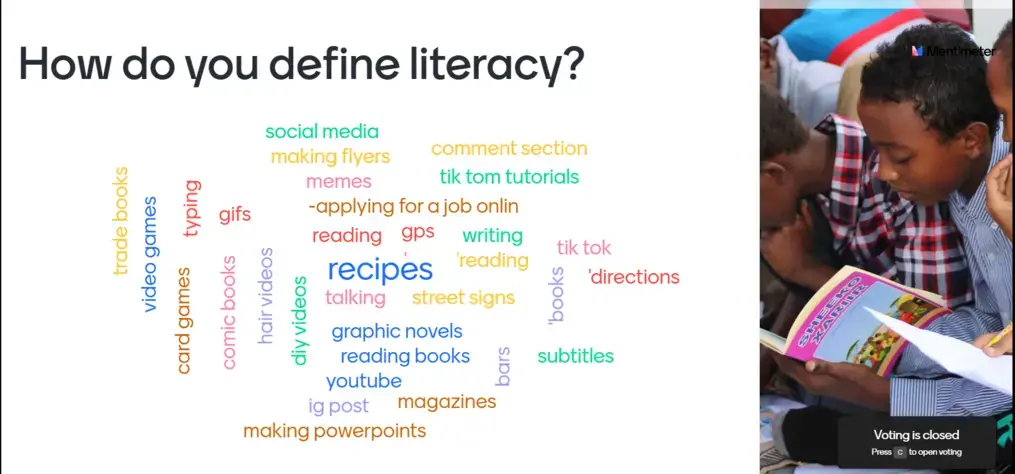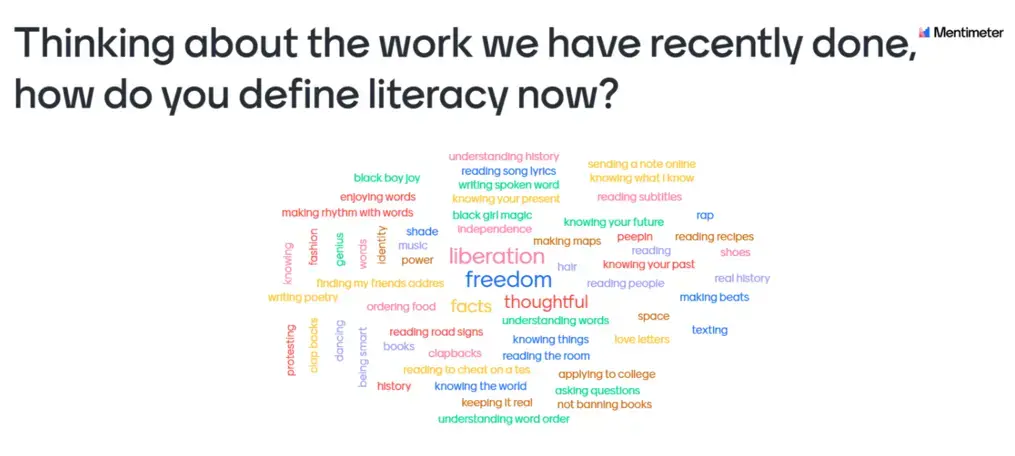This unit was created by the Good Trouble team as part of the 2022 cohort of The 1619 Project Education Network. It is designed for facilitation across approximately four weeks, or ten lessons.
Objectives
Students will be able to...
- Engage in disciplinary-specific thinking to understand and address issues of equity, power, and justice.
- Examine and explain the relationship that literacy has to the formation and perpetuation of culture and how literacy has the capacity to empower people to make meaningful choices and decisions for themselves and their communities.
- Examine what liberation is and how literacy adds to one’s ability to act as a social change agent.
- Consider languaging and the use of language as a source of liberation, connection from past to present.
- Engage in communication and problem-solving about community issues, concerns, and activities.
Unit Overview
This unit aims to help students understand the relationship between literacy and liberation. Through the examination of multiple modes of literacy, students will work to expand their working definition of literacy. Further, students will have the opportunity to analyze both historical and present-day examples of how literacy has been used to empower and to advocate for social justice.
At the conclusion of this unit and following the completion of a student-generated community literacy action project, we expect that students will be able to recognize the power of literacy in their own lives and how it may be used as a form of liberation to empower themselves and their communities.
This unit will also help students to interrogate their own literate identities and what it means to be working for liberation in those identities. Here, students become what Lorena Escoto Germán describes as “researchers, ethnographers, advocates, and writers of community affairs,” empowering them as activists in the present and in the future.
To see the unit in action, watch this video. The video includes lecture and class discussion clips, as well as teacher and student reflections on the unit.
Performance Task
Based on their learning throughout the unit, students will develop a creative product that demonstrates their views of what literacy is and what its relationship is to liberation. The product students complete is up to them, or may be determined in consultation with the teacher. It could be a painting, a poem, a video, a dance, a podcast, a collage, a song—almost anything their hearts desire. The expectation is that all students will be able to creatively detail the connections literacy has to the ability of people to advocate for their own personal, familial, and community needs.
Regardless of the form/product students choose, they must all be sure to include the following:
- Definition of literacy
- Examples of types of literacy
- Explanation of how literacy is related to ideas of liberation
- Evidence from texts that have been used in this unit
Four-week unit plan for teachers, including pacing, texts and multimedia resources. Download below, or scroll down to review key resources included in the unit plan.
Unit Resources
| Resources from The 1619 Project | Late 1773: poem by Eve L. Ewing — A creative work in conversation with the publication of Poems on Various Subjects, Religious and Moral by Philis Wheatley, a 20-year-old enslaved woman in Boston. When a publishing house in London released the book in 1773, Wheatley became the first African American to publish a book of poetry. “Traffic” by Kevin Kruse — An essay that uses traffic congestion in Atlanta as a lens to explore the intertwined histories of infrastructure and racial inequality in the United States. “The Birth of American Music” by Wesley Morris — An essay exploring the origins and influence of Black American musical sound and the ways in which it has been co-opted, scrutinized, and celebrated throughout history. |
| External Resources on Literacy and Liberation | We Do This ‘Til We Free Us by Mariame Kaba (quotes provided in the unit plan above) “The Importance of the Act of Reading” by Paulo Freire “A 'Forgotten History' of How the U.S. Government Segregated America” from NPR “Phillis Wheatley’s Existence Was Dangerous to an Idea the US was Founded On” from the Washington Post “History Reconsidered” by Clint Smith CodedSpirtuals from PBS “3 Ways to Speak English,” a TED Talk by Jamila Lyiscott “How Hip-Hop Taught My Students to Think Critically,” a TED Talk by Jamila Lyiscott |
| Local Readings into Literacy and Liberation in Detroit, MI | “A History of the Detroit Study Club” by Lillian E. Johnson, from the Detroit Public Library Digital Collections “Whitmer Settled the Detroit Literacy Lawsuit. What It Means (and What It Doesn’t)” by Nancy Kaffer for the Detroit Free Press “Detroit Students Have a Constitutional Right to Literacy, Court Rules” by Dana Goldstein for the New York Times “Students From Detroit’s Worst Schools Fight for Fair Access to Literacy” from CBS Mornings |
Michigan K-12 Standards for Social Studies
- P1.2 Interpret primary and secondary source documents for point of view, context, bias, and frame of reference or perspective.
- 2.1 Apply methods of inquiry, including asking and answering compelling and supporting questions, to investigate social science problems.
- 6.1.4 Growth and Change: Explain the social, political, economic, and cultural shifts taking place in the United States at the end of the 19th century and beginning of the 20th century.
- 7.1.1 The Twenties: explain and evaluate the significance of the social, cultural, and political changes and tensions in the “Roaring Twenties.”
Learning for Justice Standards
- Identity: Students will develop language and historical and cultural knowledge that affirm and accurately describe their membership in multiple identity groups.
- Diversity: Students will examine diversity in social, cultural, political and historical contexts rather than in ways that are superficial or oversimplified.
- Justice: Students will recognize that power and privilege influence relationships on interpersonal, intergroup and institutional levels and consider how they have been affected by those dynamics.
- Action: Students will plan and carry out collective action against bias and injustice in the world and will evaluate what strategies are most effective.
State Disciplinary Literary Essentials
- Essential Practice 1: Problem-Based Instruction
- Engages students in developing and asking questions, as well as planning inquiries.
- Engages students in disciplinary-specific thinking.
- Helps students make sense of problems at different scales, persevere in solving them, or making conjectures about solutions.
- Helps students see connections to their lives and identities by engaging in diverse real-world and issue based investigations
- Creates opportunities for students to enact literate identities connected to their learning by attending to issues of equity, power, and justice.
- Provides opportunities for students to make choices in their reading, writing, and communication.
- Offers regular opportunities for students to collaborate with peers in reading and writing, such as through small-group discussion of texts on questions of interest, and opportunities to write within group projects.
- Differentiates instructional processes and product expectations based on frequent, formative, growth-oriented feedback that affirms high academic expectations and support for all students.
- Essential Practice 9: Community Networking to Tap Into Available Funds of Knowledge in Support of Developing Students’ Content Knowledge and Identities
- Help students connect and build on in-school and out-of-school literacy practices and identities:
- Connect learning to family, cultural, and community histories.
- Connect to youth and popular culture activities and concerns.
- Address community activities, issues, or concerns and engage students in communication and problem solving about them.
- Leverage students’ literacies, learning, and knowledge to benefit their school, district, and/or community (e.g., peer education, research fairs, concerts, demonstrations and exhibitions, student-to-student mentoring, service learning).
- Enable students to communicate conclusions to authentic audiences.
- Connect to and engage with discipline-related activities and spaces in local communities (e.g., local music groups, hobby groups, museums, universities, and libraries)
- Help students connect and build on in-school and out-of-school literacy practices and identities:
1. Watch this Unit in Action
Through this video, you can watch lecture and class discussion clips, as well as teacher and student reflections on the unit. You can also read quotes from teachers and students featured in the video below.
Studying Philis Wheatley made me realize that you cannot have liberation without literacy. Just the act of being able to write and read to the level that she was went against a lot of institutions and plans to hold people like her down. Just doing that made her more liberated, and could encourage other people to find liberation.
High school student in Detroit, spring 2023 [9:38 in the video]
I watch the lights come on. I watch kids get goosebumps at things they learn about people before them. I wanted students to understand that just because you're a teenager doesn't mean you don't have significant contributions to make, both in writing and to the world.
Teacher in Detroit, spring 2023 [13:18 in the video]
2. Word Clouds on Literacy and Liberation
Classes create one word cloud at the beginning of the unit, and one near the end, in order to document how their definitions of and associations with the word literacy change over the course of their studies.


3. Blackout Poems
After learning about Philis Wheatley and her legacy as the first African American to publish a book of poetry, students craft blackout poems using an excerpt from Thomas Jefferson's negative review of Wheatley's work. Students' poems respond to Jefferson's critique and champion the relationship between literacy and liberation.
4. Collaborative Poems
Students work together to create a collective poem about a topic on which they believe others should be literate. Watch the Good Trouble team's students perform a collaborative poem about the power of music below.

